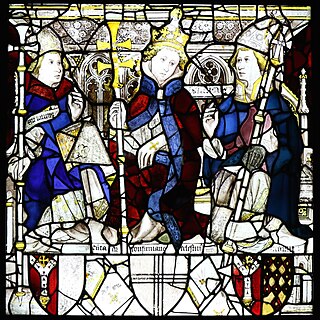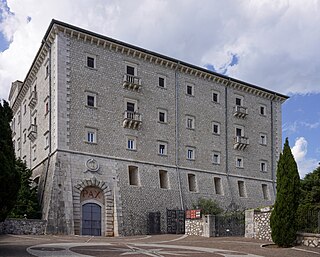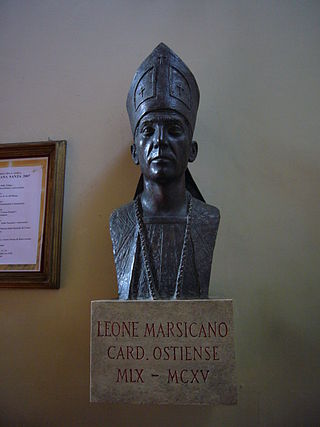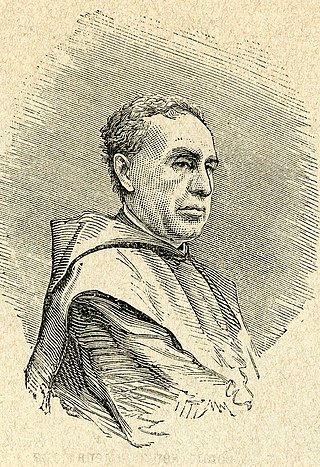Related Research Articles
Pope Honorius II, born Lamberto Scannabecchi, was head of the Catholic Church and ruler of the Papal States from 21 December 1124 to his death in 1130.

Pope Celestine II, born Guido di Castello, was head of the Catholic Church and ruler of the Papal States from 26 September 1143 to his death in 1144.
Pope Gregory VIII, born Alberto di Morra, was head of the Catholic Church and ruler of the Papal States for two months in 1187. Becoming Pope after a long diplomatic career as Apostolic Chancellor, he was notable in his brief reign for reconciling the Papacy with the estranged Holy Roman Empire and for initiating the Third Crusade.
Pope Stephen VIII was the bishop of Rome and nominal ruler of the Papal States from 14 July 939 to his death. His pontificate occurred during the Saeculum obscurum, when the power of popes was diminished by the ambitious counts of Tusculum, and was marked by the conflict between his patron, Alberic II of Spoleto, and King Hugh of Italy.

Pope Victor III, was the head of the Catholic Church and ruler of the Papal States from 24 May 1086 to his death. He was the successor of Pope Gregory VII, yet his pontificate is far less notable than his time as Desiderius, the great abbot of Monte Cassino.

Pope Julius III, born Giovanni Maria Ciocchi del Monte, was head of the Catholic Church and ruler of the Papal States from 7 February 1550 to his death, in March 1555.

Monte Cassino is a rocky hill about 130 kilometres (80 mi) southeast of Rome, in the Latin Valley, Italy, 2 kilometres west of Cassino and at an elevation of 520 m (1,710 ft). Site of the Roman town of Casinum, it is widely known for its abbey, the first house of the Benedictine Order, having been established by Benedict of Nursia himself around 529. It was for the community of Monte Cassino that the Rule of Saint Benedict was composed.

Pope Gelasius II, born Giovanni Caetani or Giovanni da Gaeta, was head of the Catholic Church and ruler of the Papal States from 24 January 1118 to his death in 1119. A monk of Monte Cassino and chancellor of Pope Paschal II, Caetani was unanimously elected to succeed him. In doing so, he also inherited the conflict with Emperor Henry V over investiture. Gelasius spent a good part of his brief papacy in exile.

Pope Nicholas II, otherwise known as Gerard of Burgundy, was the head of the Catholic Church and ruler of the Papal States from 24 January 1059 until his death in 27 July 1061. At the time of his election, he was bishop of Florence. During his Papacy, Nicholas II successfully expanded the influence of the papacy in Milan and southern Italy. He was also responsible for passing papal election reforms.
Alberic is a name closely related to Aubrey.

Leo Marsicanus or Ostiensis, also known as Leone dei Conti di Marsi, was a nobleman and monk of Monte Cassino around 1061 and Italian cardinal from the 12th century.
Alberich is the dwarf of German and Old Norse mythology

Luigi Tosti was a Benedictine historian.

Michelangelo Celesia, O.S.B. Cas. was an Italian Benedictine monk who served as the Archbishop of Palermo from 1871 until his death, and was elevated to the cardinalate in 1884.
The Conti di Marsi, the Counts of Marsi, were a lineage of Frankish origin who figured among the main feudal lords of Abruzzo, part of the Duchy of Spoleto in southern Italy, during the eleventh and twelfth centuries.

The 1099 papal election following the death of Pope Urban II took place on 13 August 1099. Before his death, Urban had designated Cardinal Rainerius da Bieda as his successor. The cardinal-electors, with the consent of the lower Roman clergy, chose Rainerius, who, after a flight and over his considerable objections, accepted and took the name Paschal II. He was consecrated a bishop and crowned pope on the next day.

The 1086 papal election ended with the election of Desiderius, abbot of Monte Cassino as Pope Gregory VII's successor after a year-long period of sede vacante.
Cristoforo Guidalotti Ciocchi del Monte (1484–1564) was an Italian Roman Catholic bishop and cardinal. On his mother's side, he was a first cousin of Pope Julius III.
Giovanni BattistaCicala (1510–1570) was an Italian Roman Catholic bishop and cardinal.
Pedro Rodríguez de Quexada or Petrus Hispanus was an ecclesiastic from Castile.
References
- ↑ Patrologia Latina , CXLV, 621-634.
- ↑ I. S. Robinson, The Papacy 1073-1198 (1990), p. 214.